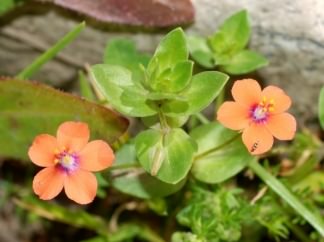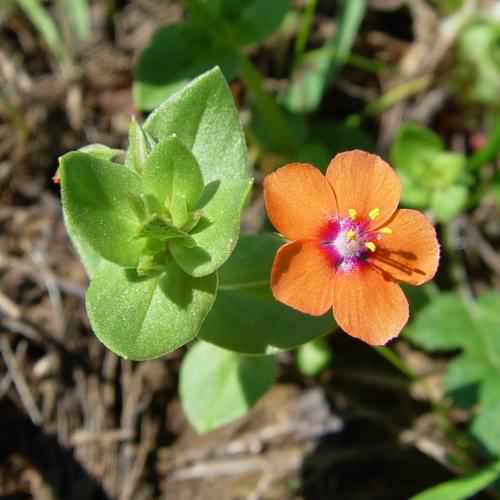
Photo ©2008 Alvesgaspar

Photo ©2004 Carol W. Witham
 Photo ©2008 Alvesgaspar |
 Photo ©2004 Carol W. Witham |
Scarlet Pimpernel - Anagallis arvensis ssp. arvensis
Family - Primulaceae
Also known as - Red Chickweed, Shepherd's Clock
Scarlet Pimpernel is an herbaceous annual plant with a prostrate creeping growth form found as a native in the UK, Europe and Western Asia and North Africa. It is now found as a naturalised invasive in most parts of the world, probably as a result of the garden and ornamental plant trade. In its native range is is regarded as a weed of many soil types, however it is possibly best known as the emblem of the fictional hero the novel "Scarlet Pimpernel" - Sir Percy Blakeney.
Growing to 5–30 centimetres (2–12in) long, on sprawling stems with square cross–section, it has bright green, soft and fleshy ovate sessile leaves in opposite pairs. Small symmetrical flowers with five petals are usually orange with a deep pink center, but can also be red or blue, are 10–15mm (0.4–0.6in) in diameter, produced singly in the leaf axils from spring to autumn. The outer edges of the flowers have small glandular hairs. Five pink stamens with bright yellow anthers attract a wide variety of pollinators, but are also capable of self pollination. The flowers only open in sunshine which has led to several common names such as "Shepherd's Clock" or "weather glass".
BCP do not advise or recommend that Scarlet Pimpernel – Anagallis arvensis ssp. arvensis is eaten or used as an herbal remedy. Apparently used in folk medicine as an external poultice for ulcers and wounds, as an expectorant and a remedy, rheumatism, haemorrhoids. In homeopathy it has been used against various rashes and nervous complaints. Anagallis arvensis is toxic to grazing animals and as such is undesirable in pastures, however it is acrid and bitter and so livestock generally avoid eating it. It can cause gastrointestinal problems and high doses could be fatal.
Site design ©1999– Brickfields Country Park - Privacy -